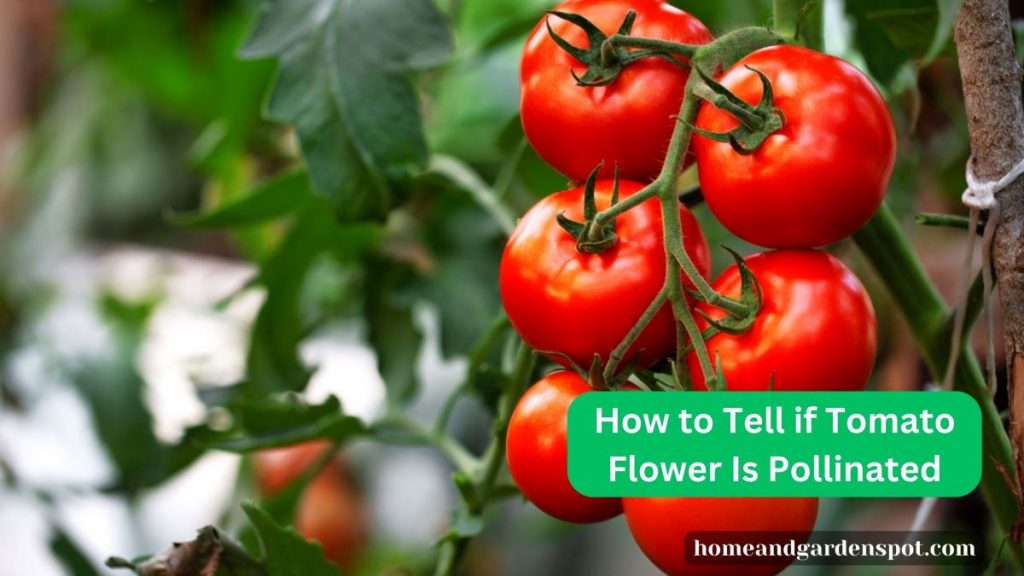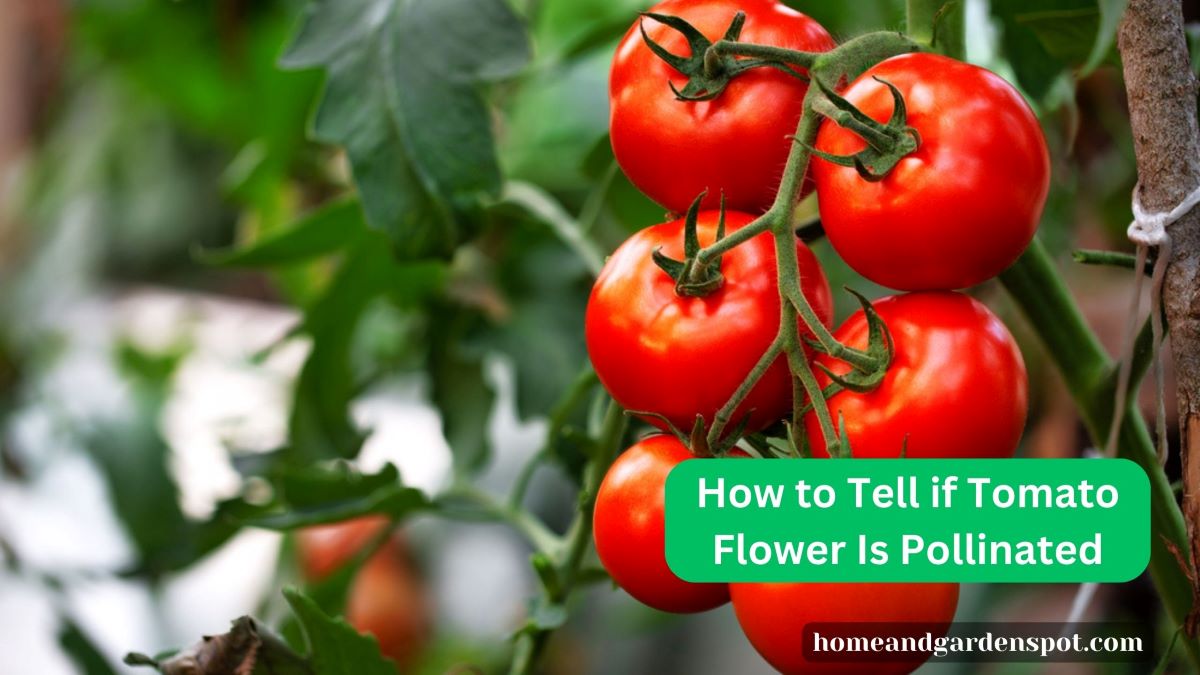The tomato holds a place, as an adored and essential crop. These vibrant and versatile fruits enhance the taste of salads, sauces, and sandwiches.
However, the process from tomato flower to fruit can be complex with pollination playing a role.
Also, understanding this aspect of tomato cultivation empowers you to nurture plants and ensure a plentiful harvest.
To help you in this endeavor, I have created a guide on how to determine if your tomato flower has been pollinated.
At the end of this blog post, I will provide you with the knowledge to recognize pollination in tomato flowers as an experienced gardener.

How to Tell if Tomato Flower Is Pollinated
Recognizing the signs of tomato flower pollination is fundamental for any tomato grower.
By observing these indicators you can actively participate in the journey from blossom to harvest while fostering your tomato plants growth to yield a thriving crop.
Here are some key signs that indicate pollination, in your tomato flowers;
1. Petal Wilt
One unmistakable sign that a tomato flower has been successfully pollinated is when its petals start wilting.
When pollination takes place the petals of the flower, which previously enclosed the tender bud begin to droop.
Eventually, drops off within a span of 2 to 3 days. This phenomenon clearly signifies that fertilization has commenced within the flower.
As the petals fade away they pave the way, for phases, in fruit maturation.
2. Changes in Color
Another visual cue of successful tomato flower pollination is a change in the flower’s color.
Tomato flowers typically start as bright yellow, but as pollination occurs and fertilization takes place, they often transition to a paler, whitish hue.
This color shift is an excellent indicator that the flower has been successfully pollinated, and the transformation serves as a beacon signaling the beginning of fruit formation.
Keep a keen eye on the color changes in your tomato flowers to gauge their reproductive progress accurately.
3. The Presence of Pollen
Successful pollination in tomato flowers is, unsurprisingly, accompanied by the presence of pollen.
Pollen grains serve as the plant’s male reproductive cells, playing an essential role in the process of fertilization.
When a tomato flower is successfully pollinated, you will observe an abundance of pollen on its reproductive structures, particularly the stigma, which is the female part of the flower.
This accumulation of pollen signifies that pollinators have visited the flower or have undergone manual pollination, initiating the process that leads to fruit formation.
4. Ovary Development
Within the heart of a tomato flower lies the ovary, a vital component in the process of fruit development.
A successfully pollinated tomato flower will exhibit notable changes in the ovary. It begins to swell and develop, marking the early stages of fruit formation.
As pollination takes hold, the ovary’s growth becomes more pronounced, and it starts to transform into the potential tomato fruit.
Monitoring the expansion and development of the ovary is a reliable way to confirm that pollination has been successful in your tomato plants.
5. Growth of the Fruit
The ultimate confirmation of successful pollination in tomato flowers is the subsequent growth of the fruit.
After the flower has been pollinated, the fertilized ovary will continue to swell and mature, eventually giving rise to the familiar tomato fruit.
This transformation from a tiny bud to a full-grown fruit is the peak of successful pollination.
As the fruit grows, it will undergo various stages of ripening, ensuring that you can savor the flavorful results of your successful tomato flower pollination efforts.
6 Common Reasons for Failed Pollination
1. Lack of Pollinators
One prevalent reason for failed pollination is the absence of pollinators like bees and butterflies. These insects are essential for transferring pollen between tomato flowers.
Without them, fertilization cannot occur, leading to unproductive flowers. To address this issue, consider planting pollinator-friendly flowers nearby or providing suitable habitats to attract these beneficial insects to your garden.
2. Unfavorable Weather Conditions
Unpredictable weather can hinder pollination efforts. Rain, strong winds, or extreme temperatures may deter pollinators from visiting your tomato plants.
In addition, excessive rainfall can wash away pollen, further limiting successful pollination.
To mitigate these challenges, consider using protective covers or planting windbreaks to create a more favorable microclimate for your tomato flowers.
3. Insufficient Pollen Production
In some cases, tomato plants may not produce enough pollen for successful pollination. Poor pollen production can result from stress factors such as nutrient deficiencies or environmental stressors.
Ensuring that your tomato plants are adequately nourished and well cared for can help boost pollen production, increasing the chances of successful pollination.
4. Flower Timing
Mismatched flowering times can lead to failed pollination. If male and female flowers on the same plant or different plants do not bloom simultaneously, there won’t be an opportunity for pollination to occur.
To address this issue, carefully select tomato varieties that have synchronized flowering patterns or consider manual pollination to ensure proper timing.
5. Pest Damage
Pest infestations can damage tomato flowers, preventing successful pollination. Insects like aphids or thrips can harm flower structures and reduce their attractiveness to pollinators.
Regularly inspect your plants for signs of pest damage and take appropriate measures to control infestations to ensure that your tomato flowers remain healthy and attractive to pollinators.
6. Poor Flower Health
Unhealthy or diseased tomato flowers are less likely to attract pollinators and achieve successful pollination.
It’s crucial to maintain proper plant health through adequate watering, disease prevention, and soil management practices.
By ensuring that your tomato plants are robust and disease-free, you increase the likelihood of successful pollination and a fruitful tomato harvest.
How to Address Pollination Issues
As a tomato farmer, sometimes, even with perfect conditions, your tomato flowers may not get pollinated. When failed pollination occurs, it’s essential to know what can be done.
Thankfully, there are a number of solutions that can prove helpful in helping you ensure your tomato pollinates correctly:
1. Provide a Helping Hand through Manual Pollination
Manual pollination is a practical solution when natural pollinators are scarce or if flower timing mismatches occur.
To manually pollinate tomato flowers, gently shake the flower’s central structure, allowing the pollen to disperse onto the stigma.
Alternatively, use a small brush or cotton swab to transfer pollen between flowers. This ensures that pollination takes place even without the assistance of insects.
2. Enhance Pollinator Attraction with Floral Diversity
Boost pollinator activity in your garden by planting a variety of flowers alongside your tomato plants. Pollinators are drawn to colorful and fragrant blooms.
Select a mix of annuals and perennials with different flowering times to provide a continuous supply of nectar and pollen throughout the growing season.
Creating a pollinator-friendly environment not only aids tomato pollination but also supports biodiversity in your garden.
3. Improve Environmental Conditions
To address pollination issues caused by unfavorable weather conditions, consider implementing protective measures.
For instance, you can use row covers or cloths to shield your tomato plants from strong winds or heavy rains.
Also, planting windbreaks or creating microclimates with structures like fences can help create more stable conditions for pollinators to thrive, ensuring successful flower pollination.
4. Address Soil and Nutrient Health
Optimal soil health is essential for robust tomato plants and successful pollination. Regularly test your soil and amend it as needed to ensure a balanced pH and nutrient levels.
Well-fertilized plants are more likely to produce an abundance of healthy flowers, increasing the chances of successful pollination.
Utilizing organic matter like compost and mulch can improve soil structure and nutrient retention, promoting overall plant health and, consequently, better pollination.
5. Pest and Disease Management
Pests and diseases can deter pollinators and damage tomato flowers. Regularly inspect your plants for signs of pest infestations or diseases and take prompt action to control them.
Employ natural predators, beneficial insects, or organic pest management methods to maintain a healthy garden environment.
By keeping your plants free from these threats, you ensure that your tomato flowers remain inviting to pollinators, facilitating successful pollination.
6. Ensure Proper Watering
Inconsistent watering practices can stress tomato plants, leading to poor flower health and unsuccessful pollination.
Provide your plants with a consistent and adequate water supply, aiming to keep the soil consistently moist but not soggy.
This stable moisture level promotes healthy flower production and keeps the plants vibrant, making them more appealing to pollinators.
By addressing watering issues, you create a conducive environment for successful pollination in your tomato garden.
How Long Does It Take for Tomatoes to Form After Successful Pollination?
Tomato plants start producing flowers when they reach a height of 12-18 inches. It typically takes about 7-10 days after the flower opens to know if it’s been successfully pollinated.
Once pollination occurs, you’ll notice small green tomatoes beginning to form. This stage lasts for the first 2-3 weeks after pollination.
After those initial weeks, tomatoes enter a growth spurt. During the next 3-5 weeks, they grow quickly and start to take shape.
As the tomatoes reach their mature size, they begin to change color and ripen. When they feel firm to the touch and display their full color, it’s harvest time.
Also, note that the time it takes for tomatoes to go from blooming to harvest can vary.
Factors like the tomato variety and environmental conditions play a role. Generally, though, you can expect it to take anywhere from 45 to 100 days for your tomatoes to ripen and be ready for your plate.
Conclusion
Recognizing the signs of successful pollination, such as petal wilt, color changes, pollen presence, ovary development, and fruit growth, is crucial for any tomato grower.
Equipped with this knowledge, you can ensure that your tomato plants are on the right track toward a bountiful harvest.
In addition to this, regularly inspecting your tomato flowers is a crucial practice. It allows you to intervene when needed, whether through manual pollination or addressing potential issues like pests or diseases.
This attentive care can make all the difference in the success of your tomato plants.

Leave a Reply